This article needs additional citations for verification .(March 2024) |
Following are the largest impact craters on various worlds of the Solar System. For a full list of named craters, see List of craters in the Solar System . The ratio column compares the crater diameter with the diameter of the impacted celestial body. The maximum crater diameter is 157% of the body diameter (the circumference along a great circle).
| Body | Crater | Crater diameter | Body diameter | Ratio | Images | Notes |
|---|---|---|---|---|---|---|
| Mercury | Caloris | 1,550 km (963 mi) | 4,880 km | 32% |  | |
| Rembrandt | 715 km (444 mi) | 15% |  | |||
| Venus | Mead | 280 km (170 mi) | 12,100 km | 2% | 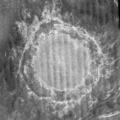 | |
| Earth | Vredefort | 250–300 km (160–190 mi) | 12,740 km | 2% |  | |
| Chicxulub crater | 182 km (113 mi) | 1.4% | 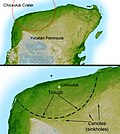 | Cause or contributor of the Cretaceous–Paleogene extinction event | ||
| Sudbury Basin | 130 km (80 mi) | 1% |  | |||
| Moon (moon of Earth) | Procellarum | 3,000 km (2,000 mi) | 3,470 km | 86% |  | Not confirmed as an impact basin. |
| South Pole–Aitken basin | 2,500 km (1,600 mi) | 70% |  | |||
| Imbrium | 1,145 km (711 mi) | 33% |  | |||
| Mars | North Polar Basin | 10,600 × 8,500 km (6,550 × 5,250 mi) | 6,780 km | 125–155% |  | Not confirmed as an impact basin |
| Utopia | 3,300 km (2,100 mi) [1] | 50% |  | Largest confirmed impact basin on Mars and in the Solar System | ||
| Hellas | 2,300 km (1,400 mi) | 34% |  | Largest visible crater in the Solar System | ||
| Isidis | ~1,900 km (1,200 mi) [2] | 28% |  | Heavily degraded to the northeast | ||
| Argyre | 1,700 km (1,100 mi) [3] | 25.1% | 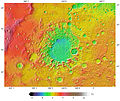 | May have an outer ring 2750 km in diameter [3] | ||
| Vesta (asteroid) | Rheasilvia | 505 km (310 mi) | 529 km (569 km) [4] | 90% [4] | 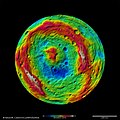 | |
| Veneneia | 395 km (250 mi) | 70% [4] |  | Partially obscured by Rheasilvia | ||
| Ceres (dwarf planet) | Kerwan | 284 km (180 mi) [5] | 952 km | 30% |  | Faint shallow crater, below the center of this image. |
| Yalode | 271 km (170 mi) [5] | 28% |  | |||
| Hygiea (asteroid) | Serpens | 180±15 | 434 ± 14 km | 40% |  | |
| Ganymede (moon of Jupiter) | Epigeus | 343 km (213 mi) | 5,270 km | 6.5% |  | |
| Callisto (moon of Jupiter) | Valhalla | 360 km (224 mi) | 4,820 km | 7.5% |  | |
| Heimdall | 210 km (130 mi) | 4% | (no good images have been taken) | |||
| Mimas (moon of Saturn) | Herschel | 139 km (86 mi) | 396 km | 35% |  | |
| Tethys (moon of Saturn) | Odysseus | 445 km (277 mi) | 1,060 km | 42% |  | |
| Dione (moon of Saturn) | Evander | 350 km (220 mi) [6] | 1,123 km | 34% |  | |
| Rhea (moon of Saturn) | Mamaldi | 480 km (300 mi) [7] | 1,530 km | 31% | 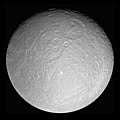 | |
| Tirawa | 360 km (220 mi) | 24% |  | |||
| Titan (moon of Saturn) | Menrva | 392 km (244 mi) | 5,150 km | 7.5% |  | |
| Iapetus (moon of Saturn) | Turgis | 580 km (360 mi) | 1,470 km | 40% |  | |
| Engelier | 504 km (313 mi) | 34% |  | |||
| Gerin | 445 km (277 mi) | 30% |  | Gerin is overlain by Engelier | ||
| Falsaron | 424 km (263 mi) | 29% |  | |||
| Titania (moon of Uranus) | Gertrude | 326 km (203 mi) | 1,580 km | 21% |  | Little of Titania has been imaged, so it may well have larger craters. |
| Pluto (dwarf planet) | Sputnik Planitia basin | ca. 1,400 × 1,200 km [8] average: ~1,300 km | 2,377 km | 54.7% |  | Partially infilled by convecting Nitrogen ice, heavily eroded |
| Burney | 296 km (184 mi) | 12.5% |  | Heavily degraded, difficult to see | ||
| Charon (moon of Pluto) | Dorothy | ca. 261 km (162 mi) | 1,207 km | 21% |  | Crater at upper right overlapping Mordor Macula |
